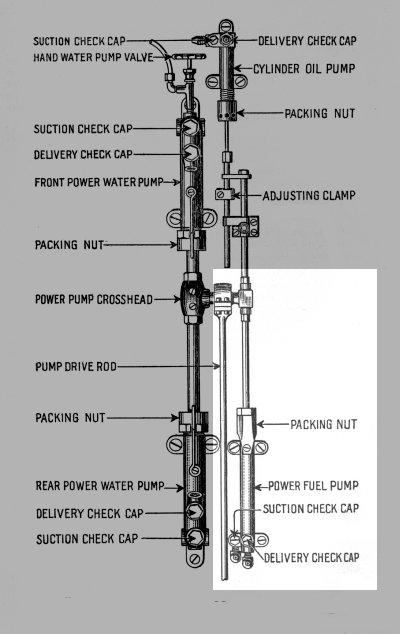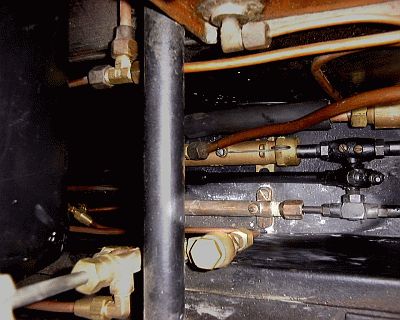|
 The
fuel pump only operates when the car is in motion as it is powered off the rear
axle of the car for later Stanley models like the Model 735 or driven from the engine
crosshead for early Stanleys. The fuel pump will pump fuel to
pressures well above the 140 PSIG setting of the fuel automatic and provides
a volume of fuel sufficient to quickly replenish what is used from the
pressure tanks while the car is stopped at a light.
The cars manufactured up through 1914
placed the pump under the driver's foot board. The fuel pump, like the
water pumps were of a "short stroke" design. Driven from the
right-hand crosshead wrist pin of the engine, a rocker arm arrangement
reduced the 4" engine stroke to the required 1-1/4" stroke of the pump's
piston.
In 1915 Stanley introduced the "long
stroke pumps" which ran at a much slower speed and were a lot
quieter than the short stroke pumps. The long stroke fuel pump has a 4" stroke
and uses a larger diameter piston than its short stroke cousin. The pumping action
relies on check valves similar to that of the water and
oil pumps. The check valve balls were 3/8" diameter. Mounted on
the right rear axle is the pump drive box. The pump drive box provides
gearing and a crank arm to drive the power pumps. At the end of the
crank arm the pump drive rod is attached. The result is that the pumps
operate at a much slower speed as a result of this design making them
quieter (see the photo and discussion at the end of the power water pumps
article for additional information).
The Stanley power fuel pump
on a condensing Stanley operates identical to the power water and oil
pumps. As the piston is drawn out of the cylinder a vacuum is created
which draws fuel from the supply tank to fill the volume
within the cylinder that the piston occupied. The fuel is drawn from
the fuel supply line and the fuel tank into the pump through
the suction check valve while the delivery check valve keeps oil from being
drawn in from the delivery piping. Actually with 140 PSIG pressure on
the delivery side of the pump, if the pump's delivery check valve is not
functioning properly the pump usually will not pump fuel.
As the piston is pushed back into the
cylinder the fuel that has been drawn in now tries to run back out of the
cylinder through the suction check valve that was open. This action
forces the suction check valve to close and pressure begins to build on the
fuel in the cylinder as the piston continues its motion into the cylinder.
When the pressure within the cylinder becomes greater than the fuel
pressure of the delivery piping after the pump, the delivery check valve
opens allowing the fuel just drawn into the pump's cylinder to escape and
flow into the delivery piping. Once the piston is fully inserted in
the cylinder no more fuel is supplied by the pump to the delivery piping
and the cycle starts over with the piston being pulled out of the cylinder
to draw in more fuel.
The power fuel pump in a Stanley is located below or at least at the same level as the
fuel supply
tank. This affords an easy way for it to be initially primed with
fuel. Rings of graphite impregnated packing are used at the end of
the cylinder to for a seal between the cylinder and moving piston.
Maintenance is generally required every couple hundred miles to snug up on
the packing nut. There is no adjustment for the amount of fuel pumped. |

